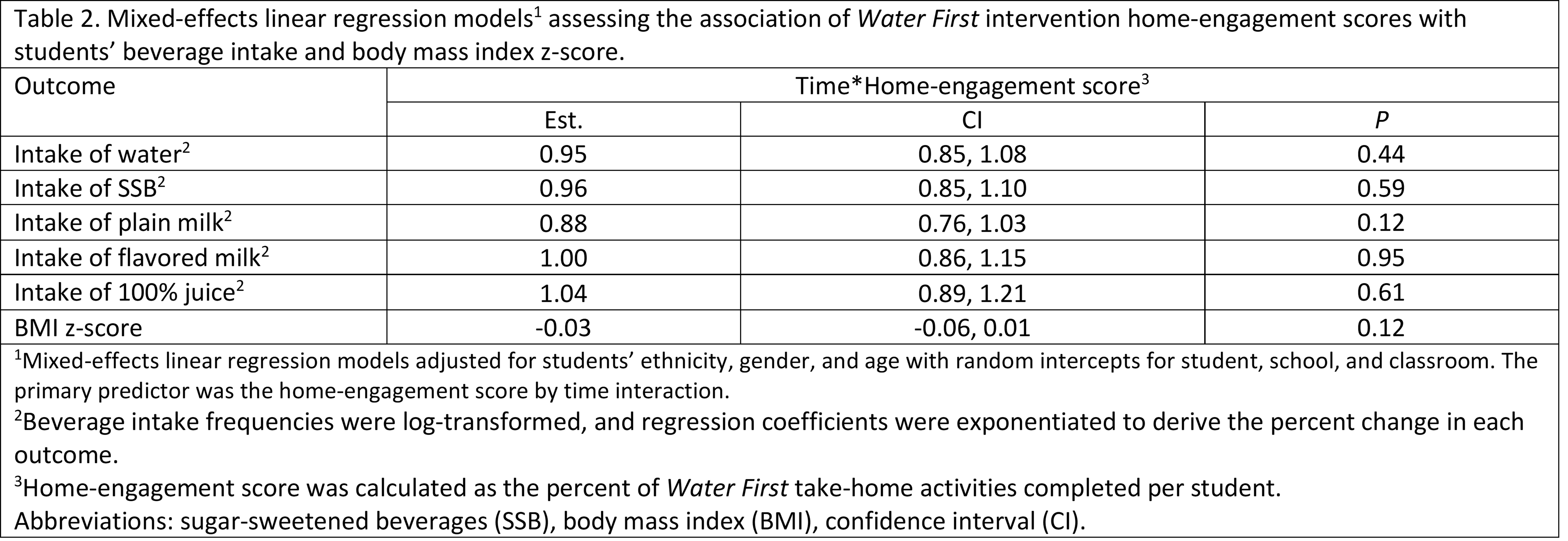Obesity 1
Session: Obesity 1
272 - Evaluating the Fidelity of the Water First Intervention Program and its Impact on Students’ Intake of Water and Other Beverages, and Body Mass Index Z-Score
Sunday, April 27, 2025
8:30am - 10:45am HST
Publication Number: 272.4864
Anjali Gupta, Stanford University School of Medicine, Cary, NC, United States; Keejeong Ryu, Stanford University School of Medicine, San Jose, CA, United States; Yadira Peralta, Center for Research and Teaching in Economics, Aguascalientes, Aguascalientes, Mexico; Valeria M. Ordonez, Stanford University, Sunnyvale, CA, United States; Charles E. McCulloch, University of California, San Francisco, School of Medicine, San Francisco, CA, United States; Laura Schmidt, University of California, San Francisco, School of Medicine, San Francisco, CA, United States; Lorrene D. Ritchie, Nutrition Policy Institute, University of California, Division of Agriculture and Natural Resources, Oakland, CA, CA, United States; Anisha Patel, Stanford University School of Medicine, palo alto, CA, United States

Anjali Gupta, BS (she/her/hers)
Medical Student
Stanford University School of Medicine
Cary, North Carolina, United States
Presenting Author(s)
Background: A cluster randomized controlled trial examining the impact of the Water First water promotion and access intervention in 18 elementary schools found the program increased water consumption and prevented overweight in students.
Objective: This study describes a secondary analysis of Water First program fidelity and association with students’ water and sugar-sweetened beverage (SSB) intake and body mass index (BMI) z-score over time in the intervention arm.
Design/Methods: Researchers observed Water First fidelity (e.g., visible water promotional material, presence/quality of study-provided water sources and drinking vessels in classrooms, school cafeterias, high-traffic areas) 2 times/week during the intervention period. Fidelity scores were created by location and summary values were calculated (0 to 1, with 1 indicating highest fidelity). Home-engagement activity completion (%) was calculated per student. Anthropometrics and past-week frequency of water and other beverage intake were assessed at baseline, 7-months, and 15-months follow-up. Mixed-effects linear regression models, adjusted for students’ ethnicity, gender, and age with random intercepts for student, school, and classroom, examined associations of intervention fidelity with the primary outcome (water intake) and secondary outcomes (SSB, milk, 100% juice intake, BMI z-score). The primary predictor was the fidelity score by time interaction. Beverage intake frequencies were log-transformed, and regression coefficients were exponentiated to derive the percent change in outcomes.
Results: Program fidelity was highest in the cafeteria (mean: 0.87, SD: 0.06) compared to other water station areas (0.66, SD: 0.15) and classrooms (0.73, SD: 0.13). There were no associations of program fidelity and water intake. Mean home-engagement activity completion rate was 0.41 (SD: 0.33). Higher classroom fidelity was associated with decreased intake of SSB (31%; CI: 0.48-0.99) and 100% juice (42%; Cl: 0.38-0.88) over time. Higher water station fidelity was associated with decreased intake of SSB (35%; Cl: 0.47-0.89) and plain milk (59%; Cl: 0.28-0.60). Higher cafeteria fidelity score was associated with 0.26 decrease in BMI z-score over time (Cl: -0.45, -0.07). No significant associations were observed for home-engagement activity completion.
Conclusion(s): The intervention was largely robust to fidelity gaps, which varied across schools and classrooms. Higher cafeteria fidelity score was associated with reductions in BMI z-score, which may be related to changes in beverage intake.
Mixed-effects linear regression models assessing the association of Water First intervention fidelity with students’ beverage intake and body mass index z-score.
.jpg)
Mixed-effects linear regression models assessing the association of Water First intervention home-engagement scores with students’ beverage intake and body mass index z-score


